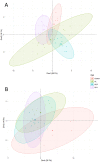Dietary Ulva lactuca and CAZyme supplementation improve serum biochemical profile and hepatic composition of weaned piglets
- PMID: 37258799
- PMCID: PMC10232413
- DOI: 10.1038/s41598-023-36008-4
Dietary Ulva lactuca and CAZyme supplementation improve serum biochemical profile and hepatic composition of weaned piglets
Abstract
Ulva lactuca is a seaweed with antinutritional cell wall for monogastrics. Carbohydrate-Active enZymes (CAZymes) supplementation can potentially cause its disruption. This study evaluates four diets: Ctrl-control diet; UL-control + 7% U. lactuca (wild caught, powdered form); ULR-UL + 0.005% Rovabio® Excel AP; ULU-UL + 0.01% ulvan lyase on piglets' haematologic and serologic profiles, hepatic lipids and minerals. White blood cells and lymphocytes reached the highest values in piglets fed UL compared to control, and to control and ULR; respectively (P < 0.05). IgG levels were boosted by seaweed incorporation compared to control (P = 0.015). The glycaemic homeostasis was assured by the seaweed inclusion. Dietary seaweed decreased serum lipids (P < 0.001), with the exception of ULU, due to HDL-cholesterol increase (P < 0.001). Cortisol was decreased in ULR and ULU (P < 0.001). No systemic inflammation was observed (P > 0.05). While hepatic n-3 PUFA increased in piglets fed with seaweed diets due to increment of beneficial 22:5n-3 and 22:6n-3 fatty acids (P < 0.05), the opposite occurred for n-6 PUFA, PUFA/SFA and n-6/n-3 ratios (P < 0.05). Hepatic pigments were unchanged (P > 0.05). ULR reduced α-tocopherol levels (P = 0.036) and increased serum potassium levels (P < 0.001) compared to control. Seaweed contributed to overcome piglets' weaning stress, with some benefits of including CAZyme supplementation.
© 2023. The Author(s).
Conflict of interest statement
The authors declare no competing interests.
Figures
References
-
- Rotz, A. Environmental sustainability of livestock production. Meat Muscle Biol.4(2), 1–18 (2020).
-
- Cardoso V, et al. Exogenous enzymes improve the nutritive value of cereal-based diets for monogastric animals through different mechanisms. In: Duarte AF, Costa LL, et al., editors. Advances in Animal Health, Medicine and Production. Springer; 2020.
MeSH terms
Substances
LinkOut - more resources
Full Text Sources


